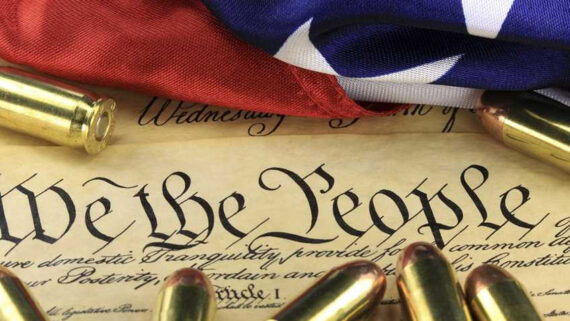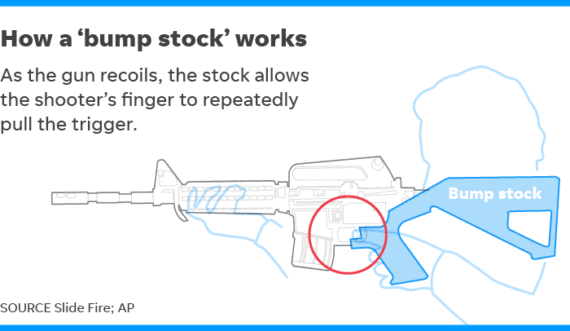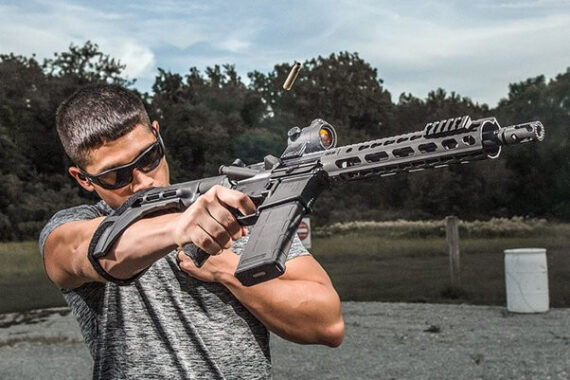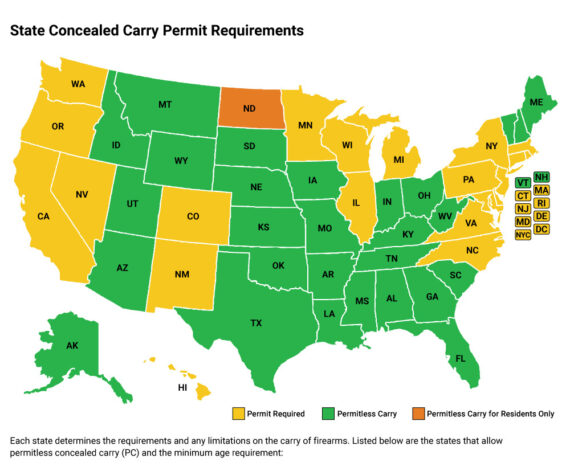Recent Changes in Firearm Laws & Regulations
The firearms laws in the United States are in continual flux. Many states, like Florida, Texas, Tennessee, and both Dakotas, are working to protect our rights to defend ourselves, our loved ones, and our property. Other states, like California, Massachusetts, and New York, are instead looking for ways to limit those rights.

Let’s not ever forget The Second Amendment to the United States Constitution. Source
The nature of governance in the United States means that navigating the firearms laws in the country can be a bit of a challenge. What may be legal in one state might be illegal in another. Additionally, the federal government can be very inconsistent in how it enforces or interprets laws, leading to confusion about what is permissible and what is not.
Here is a brief overview of some of the current developments in firearm laws and regulations to help you navigate. Of course, these can change at any moment, so always ensure that you do your own due diligence.
National Developments
In June of 2022, we saw one of the most critical rulings relating to the 2nd Amendment since the late 2000s.
Like the 2008 Heller and 2010 McDonald rulings, the 2022 New York State Rifle and Pistol Association Inc. v. Bruen (called Bruen in this article) significantly impacted how 2nd Amendment jurisprudence is ruled. Bruen moved 2nd Amendment rulings away from a legal doctrine called intermediate scrutiny to a standard called text, history, and tradition (THT). This means that courts must focus on the original meaning of the Second Amendment and historical practices at the time of its ratification in 1791.
Courts in the United States must look at three things:
- Text: Analyzing the plain meaning of the constitutional text.
- History: Examining historical context and practices around the time of the Second Amendment’s adoption.
- Tradition: Considering long-standing traditions and legal precedents that have shaped the understanding of the right to keep and bear arms.
Comparison and Implications
| Aspect | Intermediate Scrutiny | Text, History, and Tradition |
| Judicial Review | Balances government interests against individual rights using a means-end analysis. | Focuses on the original meaning and historical context of the Second Amendment. |
| Government’s Burden | Must show the law serves an important objective and is substantially related to it. | The government must demonstrate that the regulation is consistent with historical practices. |
| Flexibility | Allows for contemporary considerations and empirical judgments. | Anchored in historical interpretation, limiting the influence of modern policy preferences. |
| Criticism | Seen as allowing judicial discretion and potential bias in empirical judgments. | Criticized for potential rigidity and difficulty in applying historical analysis to modern issues. |
| Application | Widely used in lower courts post-Heller and McDonald. | Adopted by the Supreme Court in Bruen, emphasizing historical consistency. |
Bump Stocks
Following the 2017 Las Vegas shooting, the ATF classified bump stocks as machine guns. This, combined with prior gun control laws, effectively banned bump stocks.

A bump stock on an AK-style firearm. Source
Multiple individuals, businesses, and organizations challenged the ban. It was also tried in multiple jurisdictions, with both sides winning victories before the Supreme Court agreed to hear the case Garland v. Cargill.
A final ruling was handed down on June 14, 2024, in which the Supreme Court ruled that bump stocks do not meet the legal definition of a machine gun, which requires the weapon to fire more than one shot for each function of the trigger.

Demonstration of how a bump stock functions. Source
The ATF had exceeded its authority by reclassifying bump stocks as machine guns and, therefore, violated the Constitution. As it stands today, bump stocks are fully legal, and it will take an act of Congress whereby the definition of a machine gun is changed to ban bump stocks in the future.
Ghost Guns/3D Printed Guns/80% Lowers
In 2022, the Biden administration enacted a regulation that firearms kits must bear a serial number. The Administration claimed that these “ghost guns” were dangerous and allowed anyone to obtain a firearm without a background check. The wording of the ATF’s regulation, though, is vague, and it has led some to worry about how the government will interpret the regulation in the future and how it might be used to suppress the 2nd Amendment community.

Now that’s a beautiful 3D-printed Scorpion! Source
Organizations like the 2nd Amendment Foundation, the Firearms Policy Coalition, and Gun Owners of America are actively challenging the ATF and Biden administration in court over their attempts to, in this writer’s opinion, unlawfully regulate firearms parts and create a barrier to firearm ownership.
The case, VanDerStok v. Garland, is the amalgamation of several suits and will be heard by the Supreme Court in October 2024. I expect a ruling in the case by June 2025.
Pistol Braces

Shooting one-handed has never been easier. Source
Mock v. Garland is the most important court case relating to the ATF and Biden administration’s attempts to classify firearms equipped with a pistol brace as short-barrelled rifles (SBR).
Short-barrelled rifles are heavily regulated in the United States, with the regulation dating back to the 1930s era firearms law, the National Firearms Act. Violations of the NFA through possessing an unregistered SBR are punished severely, with violators receiving a hefty fine and a ten-year prison sentence.
When the ATF classified millions of pistols as SBRs by reclassifying pistols equipped with a pistol brace as SBRs, it essentially made millions of gun owners felons. Judge Reed O’Connor and the 5th Circuit Court of Appeals have ruled against the ATF’s regulation, citing failure to follow the Administrative Procedure Act (APA). This ruling was not made on Second Amendment grounds but instead on administrative grounds.
This means that the Biden administration or another administration unfriendly to firearms ownership could attempt to resurrect this ban later. As it stands now, though, the rule was vacated, meaning it is nullified and no longer enforceable.

Rare Breed is the best-known FRT. Source
Forced Reset Triggers are triggers designed to increase the shooter’s fire rate by helping the shooter reset the trigger faster after each shot. The ATF, like with bump stocks, was trying to argue that because FRTs allowed shooters to increase their rate of fire, they were essentially machine guns.
On July 23, 2024, Judge Reed O’Connor of the United States District Court for the Northern District of Texas struck down the ATF’s attempts to classify FRTs as machine guns, concluding that the ATF exceeded its authority by classifying FRTs as machine guns. Firearms equipped with an FRT still only fire one shot per function of the trigger and, therefore, are not machine guns as defined by Congress.
Commentary
What we have seen from all of these cases is jurisprudence limiting the regulatory authority of executive agencies. Courts are telling the executive branch that they may only reinterpret statutory definitions set by Congress and the legislative branch with explicit legislative action.
These decisions should set legal precedents moving forward. Whether that is true, though, remains to be seen since many sitting judges are activist in nature and appear less bound by Constitutional constraints than in prior decades.
State Level Developments
Numerous developments related to the Second Amendment occur at the state level. The number of court cases occurring in some states, combined with the number of states, makes breaking them all down in this article impractical. Here are a few highlights.
Constitutional Carry
Constitutional carry is simply carrying handguns without needing a state permit, provided you are legally allowed to own a firearm. This means individuals can openly or concealed carry their handguns without going through the bureaucratic process of obtaining a permit, reflecting a strong adherence to Second Amendment rights.

Do you live in a green, yellow, or orange state? Source
As of mid-2024, 29 states have adopted constitutional carry laws. The two most recent states to adopt constitutional carry were South Carolina on March 7, 2024, and Louisiana, whose law went into effect on July 4, 2024.
“Assault Weapon” Bans
The news on “assault weapon” (AW) bans has been neutral at best and, in reality, negative. The Supreme Court has avoided cases challenging state assault weapon bans as much as possible. The Court has not gone so far as to say that AW bans are Constitutional, but it has declined cases related to the bans or upheld procedural challenges to the bans.
Considering that opponents have begun to equate semi-automatic firearms with assault weapons, I do not expect this trend to continue. Semi-automatic firearms are the most commonly use and owned firearms in the United States. Sooner or later, the Court will take up a case that hopefully will strike down these bans for good.
Bans on 18-20 Year Olds
We also see decent movement on Second Amendment rights for 18 to 20-year-olds, especially after Bruen. Young men and women in this age group can join the military, use military equipment, and potentially die to defend the Second Amendment.
Thankfully, the courts recognize this and rule that they are part of “the people” whose rights are protected by the Second Amendment.

Jack Harold Lucas was 17 when he earned his Medal of Honor. Source
States where 18 to 20-year-olds have seen advancements in their rights in recent years include Minnesota, Pennsylvania, and Texas. These rulings mainly relate to getting a license to carry a handgun or carrying a handgun under Constitutional Carry protections.
There is one crucial Federal case called Fraiser et al. v. ATF. It challenges whether an 18-to 20-year-old can buy a handgun from an FFL. I don’t think this case has reached its ultimate conclusion, but hopefully, at some point, we will see a final ruling ensuring that 18-to 20-year-olds’ Second Amendment rights are protected the same way their other Constitutional rights are.
Last Words
As you can see, Second Amendment jurisprudence is in an almost constant state of flux. The person sitting in the Oval Office, red states vs blue states, and the current makeup of the judiciary means there are a ton of pressures on the legal system and the Constitution. It is in the best interest of those in the Second Amendment community to monitor the current court cases and know the laws in each state they may visit or reside in.
